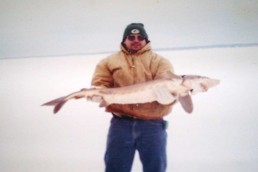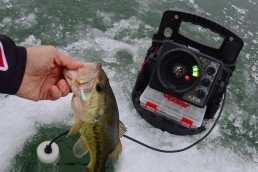A Northern Tradition: Is Your Ice Fishing Gear Ready?
SHARE THIS POST
My thoughts are now on the upcoming ice fishing season and coming up with some kind of a game plan to up my odds. After trying and using Baitmate fish attractant during the open-water season, I just may have found the ticket to do so. But taking care of your gear is also is important for improving your catch rate on the ice. And if everyone is like me, the equipment for winter fishing is usually put away in the garage with no special care taken months ago.
Now though, I will try to find out where I put every piece of gear. And when found, I lay it all out so that I can work on the equipment with little or no mess while hoping I didn’t lose anything on the ice from the previous season. What I start working on first will not matter as long as all equipment is in good working order and holds up after I’m done.
This year, I decided to start on my ice rods and reels. First, I remove and strip all old line from my spools. Then I clean and oil all my reels and wipe all dirt and cobwebs left on them from being stored in the garage. Also at this time, anything missing or broken is fixed or replaced.
For rods, this is equipment that’s likely been overlooked. First take a damp rag and wipe from the rod tip to the handle and do not overlook or forget to clean and check all the eyes. I would hate to lose a fish through the ice to bad or damaged eyes.
Concerning line, I do have an advantage over most with an electric Berkley Line Winder. This makes my job of rewinding easy and fast. Now, I have used monofilament line before, but this year I will be using FireLine. This is also a good time to wipe and clean all dirt from your spools and look for cracks or bad areas—I have seen many fish lost to bad spools. When you’re all done with your reels, do not over-spool, as this will cause a big problem when you’re jigging early and you don’t want to start the season off on a bad note.
It’s a good thing at this time to clean and oil all your tip-ups, and if they have nuts, bolts or springs, take care of them. There are many different manufacturers of tip-ups—small, big, round—so just use your best judgment. I have my tip-ups rigged for two different types of species, walleyes and northerns. Starting with the northern pike tip-ups that I use all season, remove 5 feet of ice bread, or nylon. If any part of the bread or nylon is bad it will be in that first 5 feet where you could have a problem. I use a number 8 steel leader, but you can pick your own size and weight that fits your application. Now I will choose a treble hook anywhere from a number 4 to 6 hook. Manufacturer or type is just a matter of what you feel will help you have better hook-sets. I use treble hooks that I’m comfortable with on a lake that I may be on early or late in the season.
Now that my all multi-species tip-ups are cleaned and oiled, I’ll perform one last task. If you use or have a monofilament leader, replace it now. I use a 12-inch monofilament leader with 10-pound-test. I also tie a barrel swivel between the monofilament and the braided line. Read your manufacturer’s instructions on the tip-ups you own for a problem-free season.
Are you enjoying this post?
You can be among the first to get the latest info on where to go, what to use and how to use it!
I will not be getting into ice jigs in too much detail, but just what is needed for basic care. I use a number of jigs, including Custom Jigs & Spins, Northland baits and a number of others that have worked for me over the years. I would say that a bad or rusty hook has been the downfall for many ice fishermen or open-water anglers, myself included. Just make sure all hooks are rust-free. I’ve had many hooks break off in my hand while doing a test in the middle of the ice season, and we all know we put things away when we feel that the open-water season is just around the corner.
Auger time and a spark
I have an old-school 1990 Jiffy 8-inch gas/mix auger. I have to say, if you take care of the auger or anything that has a motor it should outlive the user. I start with the blades, and for me this year I’ll be replacing them. If you are not replacing blades this year you can have them sharpened at any small engine shop, or, if you are good, do it yourself. There is one thing I do at the end of the ice season, it’s remove the gas. Make sure you start with fresh gas at the start of the season.
Next, clean and test your spark plugs. If they’re bad, replace them. I always keep a spare with me when I am out on the ice. I’ll then put Sea Foam Motor Treatment in my gas tank and perform a test-run on the engine. As a matter fact, I put Sea Foam in all my gas motors and they seem to run better, but use whatever motor treatment or fuel injector cleaner you like. When I fire my auger up I let it run for about 10 minutes. Test-run the auger every time before you hit the ice. And as always, oil and grease what is needed for worry-free equipment.
Finally, for safety on the ice, we all know there is no such thing as conditions that are “perfectly safe.” Always keep that in the back of your mind when you venture out on your favorite lake. I make sure I have a throw rope that’s 50 feet long, a life jacket, extra line, a pair of ice cleats and a first-aid kit. You never know what can happen in a moment’s notice, and we may need all the help we can get when we’re out on the ice.
Remember to have a very safe and productive ice fishing season, and to take a kid fishing with the group.
Bob Wilson may be contacted at bobgonefishingagain@yahoo.com or 608-403-1239 or on Facebook @gonefishingagainguideservice.
MWO
SHARE THIS POST
You may also like...
Did you enjoy this post?
You can be among the first to get the latest info on where to go, what to use and how to use it!
Bob Wilson
MidWest Outdoors works with more than 200 outdoor experts each year, who contribute articles based on their areas of expertise. MidWest Outdoors magazine offers more fishing and hunting articles than any other publication!


